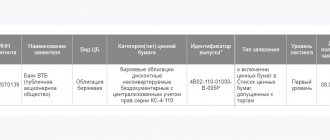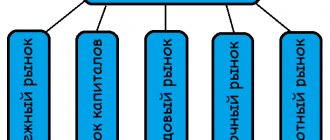Hello!
Raising capital is one of the most important tasks of companies operating in a market economy. And the main place to obtain financing is the stock market. Therefore, in this article I want to talk in detail about how the structure of the securities market works.
What applies to primary trading? Where can you make transactions to purchase investment assets? How does the derivatives section differ from the spot section? What instruments can be traded on stock exchanges? I will try to answer all these questions in clear and simple language.
Types of Securities Markets
Securities markets are divided into two types: primary and secondary.
Primary market
In this market, new securities are usually sold with the help of investment brokers. In the primary market, the issuer of the security receives the proceeds from the transaction. In the primary market, a security is traded only once—when the corporation first issues it.
Secondary market
Later, transactions take place in the secondary market, where already issued securities are traded, sold and bought. The vast majority of securities transactions occur in secondary markets, including brokerage, dealer and commodity markets.
Intermarket and intramarket participants
The activities of cross-market entities span multiple markets.
It consists of coordinating the work and serving other entities. Intermarket ones include companies, investment groups and private specialists.
Types of activities:
- working with paper assets;
- purchase and sale of real estate;
- currency transactions;
- consulting
Intramarket entities are classified as professional and non-professional. These are organizations and private entrepreneurs operating within the market.
One organization or individual entrepreneur has the right to combine services, provided that there are no corresponding restrictions in regulations. Thus, register maintenance cannot be combined with other services. However, it is possible to simultaneously provide the services of a manager, dealer, broker and depository. The clearing organization has the right to perform the functions of a depository.
Organizers of trade are considered intramarket entities.
They have the right to operate in the over-the-counter and exchange markets. Activities in the OTC field involve several reputable systems.
The stock market is considered more reliable. Responsibility for conducting the auction lies with the organizers. They also ensure that financial transactions are carried out without violations. Only reliable organizations that have passed the audit are allowed to participate in the auction.
The auction organizer interacts with entities on the basis of a license issued by the Central Bank. It does not have the right to simultaneously perform the functions of a clearing organization and a depository.
Structure of the Securities Market
The securities market is a complex structure that can be classified according to many different characteristics that characterize the organization of trade or the relationships between market participants. The main characteristics by which the securities market can be classified:
On organizing trade:
- The exchange securities market is an organized market where transactions for the purchase and sale of securities are carried out in accordance with the rules established by the exchange. Only shares of listed companies are allowed on the exchange market;
- The over-the-counter securities market is an unorganized market where the terms of the transaction are negotiated between the buyer and seller. On the over-the-counter market, securities of those issuers that have not been or do not wish to be listed on the stock exchange are traded.
By stages of issue and circulation of securities:
- The primary market is the market in which the initial placement of securities occurs. The initial placement can be private or public (IPO - initial public offering). In the first case, securities are purchased by a certain number of persons without disclosing financial information. In the second case, placement occurs through intermediaries with open financial indicators;
- The secondary market is a market in which already issued securities are resold. Its main participants are speculators who make money on the difference in prices between the purchase and sale of securities.
Geographically:
- National - the securities market within a certain state, where the redistribution of its financial resources between economic entities occurs;
- Regional is a market within a certain region with a closed turnover. A regional market can be formed either within one country or combine several national markets;
- International is a world market where securities are traded between different countries and regions, ensuring the movement of capital between them.
By issuer:
- The government securities market is the market for the circulation of government debt securities issued primarily to pay off government budget deficits or government projects;
- Corporate securities market - issuers are commercial enterprises.
By type of transaction:
- Cash market – market for immediate execution of transactions (up to 2 working days);
- The derivatives market is a derivatives market with deferred execution of transactions.
By trading method:
- Traditional market - trading takes place on the exchange directly between the seller and the buyer;
- Computerized market - trading takes place through computer networks in the presence of an exchange trading terminal.
At this stage of development of the securities market, trading through the World Wide Web is available to almost everyone. Trading terminals allow you to monitor the progress of trading on the stock exchange in real time and make transactions with your favorite securities.
Depositories
Depositories operate on the basis of a concluded agreement.
They provide services related to securities and their storage: they carry out settlements on transactions, accompany the transfer of ownership of shares and bonds.
A separate type of activity is maintaining a register of those who own assets. Registry holders are registrars. Their function is to keep information up to date. The holder collects information, analyzes it, processes it, and then enters it into the register. Only legal entities have the right to such activities. Upon request, the holder provides information to the owners of shares, bonds, and other securities.
There is a restriction on trading: if the register contains information about the owners of shares of any issuer, the registrar has no right to trade them.
Data contained in the list:
- information about the owners;
- the number of securities owned by each;
- detailed characteristics of assets (nominal value, category).
Information can be provided in electronic and paper versions.
List of works performed within this type of activity:
- maintaining a special journal in which incoming and outgoing documents are recorded;
- control of accounts of persons previously included in the register;
- keeping a log with data on completed transactions;
- accounting of certificates for bonds and shares;
- preservation of all primary reporting, on the basis of which changes are made to the list.
Features and specifics
Legal ownership of a security is confirmed in the document itself. Legitimacy is recorded in its text, which indicates the owner’s details and legal permission to possess. In order to carry out any activity or transfer rights to another owner, it is necessary to register the Central Bank in a special register (regular or computerized), which determines its legality for both parties. The list of documents includes all types of properly executed papers that contain a certain value in the general market. All of them are recognized as elements of securities at the state level. The most popular central banks in most countries:
- bonds of different forms of origin;
- bills;
- checks of the established form;
- a savings book of any bank for its owner;
- bill of lading;
- shares of any enterprises and organizations;
- certificates for deposit or saving money in an account;
- privatization securities.
The inviolable condition that distinguishes this type of document from ordinary ones is its recognition as valuable by virtue of the law or in the manner established by it. If the document contains any violations, inaccuracies, gross neglect of form or errors in the order of execution, as well as the absence of the necessary details, then it will be considered incompetent. If we talk about any possibilities of the paper, then it will not have any legal, financial or contractual force. Therefore, it can be classified as a canceled and failed securities market.
Securities define certain rights for the person who owns them:
- Cash. Documents confirming the right to receive money: bills, checks or bonds. With their help, the owner gets the opportunity to use a certain amount as invested funds in any legal industry, use them for patronage and other purposes that he chooses independently.
- Commodity. They assign property rights to a person. Often this is the right of ownership or right of pledge to a commodity object that is owned by another person: bills of lading, delivery orders.
- Share certificates. Documents confirming the owner's right to own a certain number of shares.
In addition, for a simplified method of identifying securities, they are also divided into the following types:
| From the method of legitimizing a person | Depending on the type of entity issuing the securities | From placement order |
| bearer | state | emission |
| personalized | individual subjects | non-emission |
| order | municipal | |
| corporate |
Securities in the scope of their legal use can be internal and external. Internal papers are documents that have legitimacy and a legal guarantee in the territory of the country in which they were received. Their actual value is determined by the national currency, and the right to receive or transfer money is exercised only within the state border. All other options are external.
Today, most central banks have lost their original form thanks to technological progress and digital technologies, which have long weakened the position of their paper counterparts. It is becoming increasingly rare to see Central Banks in paper or documentary form, since the so-called virtual format is in obvious demand. The paper itself is not defined as a physical object. This greatly facilitates the process of document movement, since the computerized system eliminates the possibility of its loss or physical deformation.
What are blue chips
A potential trading floor player should know not only what the stock market is, but also what blue chips are. This term refers to the assets of large and stable organizations. There is no list of companies whose shares are called blue chips.
This concept is used if:
- The company has been present on the trading platform for a long time.
- The organization's assets have high liquidity and low volatility (their price is not variable).
- The organization has high income compared to competing firms.
- The company must have high capitalization.
Will it work out or not?
It is known that any games on the financial market or stock exchanges carry a certain degree of risk. In other words, this is a game of survival, where the most attentive and fastest get the maximum profit. Before you legally enter into trading on the stock or securities market, you should remember that no investor, trader or speculator is protected from a possible price collapse or bankruptcy, even with many years of experience. The financial market exists by its own rules, and one of them is inevitable losses. This is one of the components from which no participant is immune.
At the moment, due to the popularity of buying or selling securities, there are a lot of new technologies and developments that greatly simplify the workflow for trading on exchanges. Full automation of the stock market stimulates the development of new lines of behavior. In order to build the right working strategy, you should carefully prepare, conduct several simulated situations, take into account the likely losses and risks both for yourself and for the stock market. The preparation may take a lot of time, but it will help create a solid foundation for getting started in the financial sector. This type of investment of personal free funds is not only an option for obtaining additional profit, but also an opportunity to stay on top of events in the financial world.











